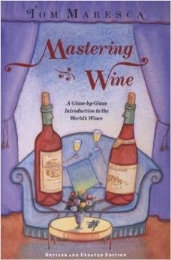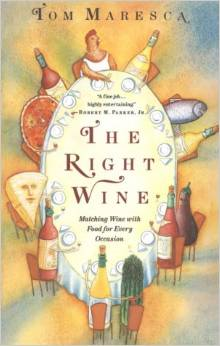Richard Elia, founder and publisher of The Quarterly Review of Wines, has posted on its website an eloquent explanation of his magazine’s closure as a print publication late last year, after 35 years. A sad occasion, but a sign of the times, perhaps: The Wine News had preceded it into oblivion a few years before, and wine articles had disappeared from general-interest magazines before that. Newspaper circulations are down, and internet wine information (soi-disant) is proliferating. All that leaves not much room for a journal that aimed at sophisticated wine drinkers of passion and discrimination, already a seriously self-limiting audience. (Does that sound snobbish? I think of it as factual.)
Elia’s online essay is called “Wine’s Decline: The Romance of Wine Is Spent,” and it laments the replacement of wine’s formerly colorful cast of characters – Elia cites André Tchelistcheff, Alexis Lichine, André Simon – by faceless and characterless corporate types. Even more distressingly, he deplores the submersion of the passion and drive to make great, personal wines in a flood of market research and numerical ratings. (Read his essay here. And see also the commentary of Tom Hyland.)
Elia makes a strong case, and a moving one: Much indeed has been lost. There are no more Luigi Veronellis or Giorgio Grais, no Edoardo Valentinos, and all too soon there will be no more Franco Biondi-Santis. Pioneers like Renato Ratti and Giacomo Bologna are long gone, as are retailers as passionate and devoted as the still-lamented Lou Iacucci – that is now a rare breed indeed. I could give you similar doleful litanies for France and California, but the easiest way to see what has passed is to look to Bordeaux and see how many estates are now owned by corporations or insurance companies or banks or have been conglomerated under a single ownership. What used to be proudly idiosyncratic is now the province of suits. As Kurt Vonnegut would say, So it goes.
And yet, and yet …. It ain’t all bad. I’m certain I qualify as an old fart, and I know I’m as much given as anyone to lamenting the passing of the good old days. I agree emphatically with most of what Elia says. Particularly I deplore, as he does, the noise levels in restaurants that make conversation impossible and paying attention to what you’re eating and drinking difficult at best. That’s why Diane and I seldom dine out any more (actually, that and restaurant wine markups), unless we can find a restaurant that still believes its primary purpose is to feed its clients rather than deafen them.
But for those of us who love wine, as Elia surely does, it has to be admitted that we are in fact living in a golden age of wine. There is more good wine being made today, by more people, in more places, than ever before.
Yes, there are oceans of grape swill being made as well, and they will continue to be made and marketed as long as there are people foolish enough to buy them. We’ve all encountered people who drink wine – why, I’ve never understood – that they purchase by price alone. I am not exaggerating when I tell you I’ve met a publisher of a small newspaper who told me that he doesn’t believe in spending more than $3 for a bottle of wine.
But, but …. There is an up-side to all these downs. Because of that technology we too often complain of, because of those crass commercial incentives, because even of global warming (think of the string of great vintages in Burgundy and in Piedmont), but most of all because there still are winemakers out there who care passionately about what they’re doing, people who would probably still work their hearts out to make great wine even if they couldn’t command the kind of prices for it that the market now allows – for all those reasons, I think this is not the time to give up on the wine world.
I don’t think it will ever again be the kind of clubby little knot of connoisseurs it once (supposedly) was. But the passion that I see in winemakers in France and Italy (the areas I know best), the curiosity to explore neglected varieties and to preserve local traditions – those are things that tell me that the romance is still alive. Yes, I’ll admit that one man’s romance can be another man’s hype. I can even accept that the same thing can be both; there’s a market too for folklore and traditions. But that doesn’t alter the fundamental fact: A person willing to take the trouble to learn a little bit can easily find fine wines to reward the effort.
The rub, perhaps, is “taking the trouble to learn a little bit.” As Elia observes, nobody seems to want to do that anymore. Nothing – nothing of any sort – teaches you about wine like the drinking of it, tasting a wine by itself, with different foods, in different vintages, in comparison with other similar and dissimilar wines. But that takes time and effort and a willingness to pay attention, take notes, and remember. Apparently – and Elia is surely right about this – most people can’t be bothered to do that, when they can call up a numerical score on their iPad and place any wine exactly in its predestined place in the wine universe and be assured thereby of their own exquisite taste. If you can buy expertise and knowledge the same way you buy a pair of shoes or a new app, who needs experience?
Regard that question as rhetorical: We all need experience. There is – ask any wine professional – a huge difference between theory and practice. Just knowing the number that the Wine Advocate or the Wine Spectator assigned a wine tells you exactly zero about the wine, and less than zero about how much or little you will enjoy it. Only your own experience will tell you that – and people who are now starting to foray into the world of wine are blessed beyond measure by the bounty of splendid wines available for them to learn from.
Despite that, some no doubt will settle for plonk. Some will become the kind of wine poseurs we all hate. But some surely will catch the passion and carry on the tradition of discrimination and refined enjoyment whose passing Richard Elia – prematurely, I hope – laments.
Postscript: I received this e-mail from Burton Anderson. I’m posting it here so that I can provide a link to his book excerpt.
Dear Tom: Just read your new post and, of course, found myself in total agreement, not only with your words but also those of Richard Elia. For what it’s worth, I’ve attached an excerpt from a chapter of a book I’m working on.
Best, Burton





